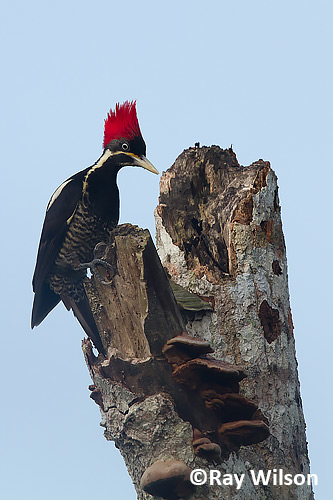
- Home
- Photography Tours
- Diary / Blog
- Galleries
- Foreign Trips
- Tasmania 2016
- NE Queensland 2016
- Western Alps 2016
- NE Spain 2016
- Australia's Wet Tropics 2015
- Australia's Top End 2015
- SW Australia 2015
- Switzerland 2015
- Andalucia 2015
- Belize 2015
- Australia 2014
- Switzerland 2014
- Belize 2014
- Bahama Islands 2014
- Switzerland 2013
- Ecuador 2012-2013
- Florida 2011-2012
- Vancouver Island 2011
- Australia 2010
- Peru 2008
- Bulgaria 2007
- Lesvos 2006
- California 2006
- New Zealand 2005
- Extremadura 2005
- Goa, India 2004
- The Gambia 2003
- About
Belize & Tikal
February-April 2014
Part 4 : Crooked Tree Wildlife Sanctuary

The High Temple at Lamanai
On the penultimate day of my stay at Bird's Eye View Lodge, I took a day-trip to the Mayan archeological site at Lamanai. At its height the city of Lamanai is estimated to have supported over 50,000 people and the area has been continuously occupied since at least 1600BC, although today the village of Indian Creek is a pale shadow of the former glory of the ancient Mayan city and most of the whole area has been reclaimed by the jungle.
Of the four large temples that have been excavated, the High Temple (above) has the highest exposed height, rising 33m (108ft) above the forest floor. At only 12 feet lower, the Temple of the Jaguar (below), however, is probably of even greater stature, as much of its base remains covered.

Temple of the Jaguar, Lamanai
The intricate, shallow carvings on the stela on the temple below gives important details of the history of Lamanai and was carved sometime after 625AD as both that date and 608AD are mentioned in the carvings.

Stela 9 Temple, Lamanai
The remains of an old 19th-century British sawmill can also be found at Lamanai. The sawmill was never actually opporational. After the building was completed, they quickly realised the foundations of the building were far too weak for the size and power of the machinery they had installed and if it were to be turned on, the vibrations from the machinery would have torn the building apart!

Strangler fig growing through an abandoned 19th-century sawmill
.As we were walking between the temples a troupe of Howler Monkeys deafened us with their calls as they sat in the trees just 5m (15ft) above our heads, providing me with an excellent opportunity to get some nice, frame-filling headshots...

Yucatan Black Howler (Alouatta pigra)

Yucatan Black Howler (Alouatta pigra)

Yucatan Black Howler (Alouatta pigra)

Yucatan Black Howler (Alouatta pigra)
Birdlife around the ruins was difficult to find, due to being there at a sub-optimum time of day and also the presence of about 500 cruiseship day-trippers didn't help either! We did, however, still manage to find a couple of good birds, such as the Slaty-tailed Trogon and Red-throated Ant-tanager shown below.

Slaty-tailed Trogon (Trogon massena)

female Red-throated Ant-tanager (Habia fuscicauda) |

unidentified Bat sp. |
We also found several small colonies of bats, such as the ones roosting on a riverside tree in the photo above.

Black Orchid (Prosthechea Cochleata)
The Black Orchid is a fairly common orchid in the forests of Belize and it has been adopted as the national flower of the country.

Passion Flower (Passiflora urbaniana)

Orb-weaving spider (Araneidae)
Back at Crooked Tree, my final day at Bird's Eye View Lodge was again spent walking the roads around the southern end of the village.

White Ibis (Eudocimus albus)
White Ibis numbers seemed to be increasing as the water levels gradually receeded, while it was impossible to resist taking yet more photos of the regular Bare-throated Tiger-herons in their usual spot...

Bare-throated Tiger-heron (Tigrisoma mexicanum)
Easily approachable, large, noisy groups of prehistoric-looking Groove-billed Anis were frequently encountered too. Like all other Anis, they are, unusually for members of the Cuckoo family, extremely social birds and roam the countryside in close-knit family groups.

Groove-billed Ani (Crotophaga sulcirostris)

Orchard Oriole (Icterus spurius)

male Rose-throated Becard (Pachyramphus aglaiae)

Pale-billed Woodpecker (Campephilus guatemalensis)
On one single branch of a dead tree, two Pale-billed Woodpeckers were competing for a nesthole with a Lineated Woodpecker, affording me the opportunity to get good images of both species at one go!

Lineated Woodpecker (Dryocopus lineatus)

Spot-breasted Wren (Thryothorus maculipectus)
Black-and-white Warbler has been something of a nemesis bird for me as far as photography goes. I've seen hundreds of them this year already, as it is one of the commonest wintering warblers in both here in Belize and the Bahamas where I spent most of January, but I just never seem to encounter any that are willing to jump onto an open perch long enough for me to get a decent shot of them. I finally remedied that this morning and got several good, full-frame photos. Now I just need to find a co-operative adult male in full spring plumage...

immature male Black-and-white Warbler (Mniotilta varia)

Black-and-white Warbler (Mniotilta varia)
Ray Wilson owns the copyright of all images on this site.
They may not be used or copied in any form without prior written permission.
raywilsonphotography@googlemail.com